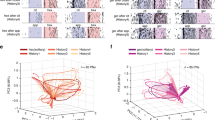Abstract
Several critical issues associated with the processing of olfactory stimuli in animals (but focusing on insects) are discussed with a view to designing a neural network which can process olfactory stimuli. This leads to the construction of a neural network that can learn and identify the quality (direction cosines) of an input vector or extract information from a sequence of correlated input vectors, where the latter corresponds to sampling a time varying olfactory stimulus (or other generically similar pattern recognition problems). The network is constructed around a discrete time content-addressable memory (CAM) module which basically satisfies the Hopfield equations with the addition of a unit time delay feedback. This modification improves the convergence properties of the network and is used to control a switch which activates the learning or template formation process when the input is “unknown”. The network dynamics are embedded within a sniff cycle which includes a larger time delay (i.e. an integert s <1) that is also used to control the template formation switch. In addition, this time delay is used to modify the input into the CAM module so that the more dominant of two mingling odors or an odor increasing against a background of odors is more readily identified. The performance of the network is evaluated using Monte Carlo simulations and numerical results are presented.
Similar content being viewed by others
Literature
Amit, D., H. Gutfreund and H. Sompolinksy. 1985. Storing infinite numbers of patterns in a spin glass model of neural networks.Phys. Rev. Lett. 55, 1530–1533.
Boeckh, J. and K. D. Ernst. 1987. Contribution of single unit analysis in insects to an understanding of olfactory function.J. comp. Physiol. A161, 549–565.
Getz, W. M. and R.F. Chapman. 1987. An odor discrimination model with application to kin recognition in social insects.Int. J. Neuroscience 32, 963–967.
Gross-Isseroff, R. and D. Lancet. 1988. Concentration-dependent changes of perceived odor quality.Chemical Senses 11, 455–470.
Hebb, D. O. 1949.The Organization of Behavior. New York: Wiley.
Homberg, U. 1984. Processing of antennal information in extrinsic mushroom body neurons of the bee brain.J. comp. Physiol. A154, 825–836.
Hopfield, J. J. 1982. Neural networks and physical systems with emergent collective computational abilities.Proc. natl. Acad. Sci. U.S.A. 79, 2554–2558.
Hopfield, J. J. and D. W. Tank. 1986. Computing with neural circuits: a model.Science 233, 625–633.
Jacobs, R. 1988. Increased rates of convergence through learning rate adaptation.Neural Networks 1, 295–307.
Kaissling, K. E. 1987.R. H. Lectures on Insect Olfaction, Konrad Colbow (ed.) Burnaby, British Columbia: Simon Fraser University.
Kaissling, K. E. and E. Priesner. 1970. Die Riechschwelle des Seidenspinners.Naturwissenschaften 57, 23–28.
Kleinfeld, D. and H. Sompolinsky, in press. An associative network model for central pattern generators. InMethods in Neural Modeling: From Synapse to Network, C. Koch and I. Seger (eds). Cambridge, MA: MIT Press.
Kohonen, T. 1988. An introduction to neural computing.Neural Networks 1, 3–16.
Maes, F. W. and G. Harms. 1986. Neural coding of salt taste quality in the blowflyGalliphora vicina: I. Temporal coding.J. comp. Physiol. A159, 75–88.
Maes, F. W. and A. C. C. Ruifrok. 1986. Neural coding of salt taste quality in the blowflyGalliphora vicina: II. Ensemble coding.J. comp. Physiol. A159, 89–96.
Menzel, R. 1983. Neurobiology of learning and memory: the honeybee as a model system.Naturwissenschaften 70, 504–511.
Newman, C. M. 1988. Memory capacity in neural network models: rigorous lower bounds.Neural Networks 1, 223–238.
O’Connell, R. J. 1986. Chemical communication in invertebrates.Experientia 42, 232–241.
Payne, T. L., M. C. Birch and C. E. J. Kennedy (eds). 1986.Mechanisms in Insect Olfaction. Oxford: Oxford University Press.
Peretto, P. 1988. On the dynamics of memorization processes.Neural Networks 1, 309–322.
Selzer, R. 1984. On the specificities of antennal olfactory receptor cells ofPeriplaneta americana.Chemical Senses 8, 375–395.
Sinclair, W. B. 1984.The Biochemistry and Physiology of the Lemon and Other Citrus Fruits, p. 946. Oakland, CA 94608-1239: University of California Division of Agriculture and Natural Resources.
Author information
Authors and Affiliations
Rights and permissions
About this article
Cite this article
Getz, W.M. A neural network for processing olfactory-like stimuli. Bltn Mathcal Biology 53, 805–823 (1991). https://doi.org/10.1007/BF02461485
Received:
Issue Date:
DOI: https://doi.org/10.1007/BF02461485




